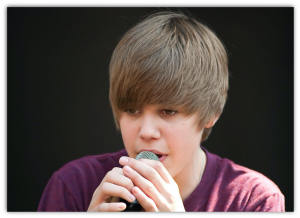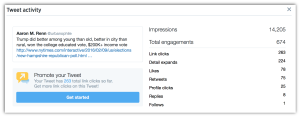
Continuing from the last post, I want to talk about what I call the “myth of the viral tweet.”
When I started getting traction with my blog I said to myself, “Hey, there’s something real here.” I thought that if I could just get some high profile exposure, like a writeup in the New York Times or a mention in a talk by a governor or something, that everyone would see how great I am and I would instantly make it big.
Ok, I didn’t quite think that. But I did have this idea that one of the big things I needed was a “lucky break” so that I could “get discovered.”
We hear all kinds of stories about this. We hear about homemade You Tube videos that go viral and lead to a record deal, for example.
I’ve noticed so often in reading profiles of people that there two major types of “origin stories” that I hear a lot. In one, somebody gets a random call out of the blue from a famous person who plucks them from obscurity. For example, “I was just sitting in my studio trying to figure out how to pay this month’s rent, when I got a call from Frank Gehry to design the lighting for his new Guggenheim Museum. He said he saw my student exhibition at the Salone del Mobile and loved it.”
The other involves someone who effectively bluffs his way into a job through some audacious act. “I walked into Vogue’s offices, knocked on Anna Wintour’s door, and told her that Steven Meisel sent me. She said they needed an emergency replacement photographer on their fashion shoot that afternoon, and I ended up on the cover.”
Do these sorts of things actually happen? Yes, on occasion. But most of these stories are bogus. They are manufactured history.
In my particular case, I have had many articles generate big traffic. For example, my New Geography piece the White City has page views well into the six figures. I’ve also made connections with several very important people.
But none of these translated into some huge break. Usually they don’t even generate much in the way of new regular readers.
Let’s use Twitter to look at this. My average tweet draws a bit over 1500 impressions. (You’ll note virtually all of my increased impressions were from increased tweeting, though my % increase in impressions is higher than the % increase in tweets – there’s a social media lesson about volume right there).
I have some tweets that do a lot more than this. Here, for example, is a Tweet about Donald Trump’s demographics in the New Hampshire primary that drew about 10x my normal impressions. It was also retweeted 75 times, so exposed me to many new people no doubt.
Did I get any spike in followers off of this? No. I get about 5-6 new followers per day consistently, regardless of Twitter impressions. Some days are more, some days are less, but there has never been a huge spike as far as I know.
The same has been true for my blog subscribers and basically everything else I’ve done. It’s been steady, organic growth over time. My readership appears to have been primarily attracted through word of mouth.
I know a lot of people who have achieved some level of success in their fields, and all of them whose story I know tell a similar story. I also know people who received extremely high quality A-list type validation and promotion who did not get a career breakthrough out of it. There were no short cuts to success. It was all about being a “ten year overnight sensation.”
The “viral tweet” phenomenon does occur. I’m not saying it never does. But that is far from the norm. From what I’ve seen, most of the “gone viral” or “got discovered” events are in music or some other type of entertainment culture, often among people who are very young. Justin Beiber (if the stories about him are actually true) is an example.
But teenage pop culture is tailor made for this. After all, Hannah Montana can’t stay 16 forever, and thus there is by necessity a need to turnover the entire teenager entertainment market every few years.
All this is not to discourage you, but to encourage you to have reasonable expectations about your path.
This is also not to say you won’t have breakthroughs. They do come and they are important. For example, nobody wants to quote you if nobody has quoted you. Getting that first piece of validation is key to getting the rest. But the path is a series of small breakthroughs like this, not one mega-exposure event.
The bottom line is that if you want to accomplish something big, you need to work hard and execute day in and day out for years to get where you want to be. And get not just one, but a series of “lucky breaks” along the way.
The truth is, if you’ll admit to yourself, you already know this. We’re all just hoping inside that we don’t have to put in the hard work. But there is no substitute.
Justin Beiber photo by Daniel Ogren (CC BY 2.0).
from Aaron M. Renn
http://www.urbanophile.com/2016/02/17/the-myth-of-the-viral-tweet/


No comments:
Post a Comment